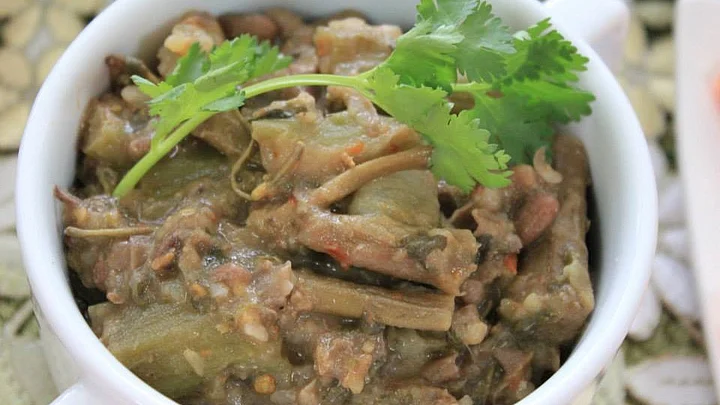Yes, a greater part of the geography of India’s Northeast is still unexplored. But as enigmatic as the region’s natural landscape – the beautiful Khasi hills, the rain-drenched forests of Cherrapunji – is its cuisine. What makes the cuisine interesting is the use of unusual meat and locally sourced ingredients that lifts the flavours of the dishes. So if dog meat is had with great gusto in Nagaland, pigeon meat, amlori toop (red ant chutney) and leta (silkworm larvae) are very popular in Assam. So this World Food Day, here's a look at some exotic dishes from a few regions of the Northeast – the land of the seven sisters.
1. Koldhil Paro Manghosh
Well for those of you who cannot imagine pigeon meat to be a delicacy, this one’s just for you! This exotic Assamese dish is made with pigeon meat and banana flowers. The pigeon meat is cut into small pieces and mashed with tender banana flowers. To this, condiments and spices are added and the mixture is cooked over a low flame. This dish is popularly had with rice.
“I remember having this dish at my Enai's (maternal grandma’s) place on special occasions. During the main festival of Rongali Bihu we would have this with Red Ants eggs chutney or amlori toop and leta or Silkworm Pupae. But now because of health reasons pigeon meat is rarely had – it makes your blood pressure shoot up”, says Mayuri R Konwar, who hails from Assam.
2. Tungtap
This dish from Meghalaya is a dry fish paste or chutney. For the fish paste, the fish is sundried for 3-4 days and kept in jute bags. It is then salted and again stored for 3-6 months. The fish is then ground with caramelised onions and fresh green chilies. Arundati Ghewali, who hails from Shillong says, “It has a strong smell, but every time I think of it, I cannot help but salivate”. She reminisces about having this with rice.
So for all those of you visiting Meghalaya, make sure to try this the next time you are there!
3. Kumurat Diya Hanhor Mangxo
Duck meat is considered auspicious in Assam and this dish is prepared during special occasions, like when the son-in-law comes visiting or during Rongoli Bihu. This dish is a strange combination of duck meat and ash gourd or komura. The duck meat is cooked with ash gourd and flavoured with black pepper and spices.
4. Rongmei Naga Curry
Though its not very rare to find dog meat and hornet larvae in a typical meat market in Nagaland, the Nagas love their pork dishes. The Rongmei Naga curry is a vegetarian dish cooked in a non-vegetarian style in Nagaland. Cabbage is sliced and cooked in pork fat, from which it gets its special flavour.
“The intense taste of the melted pork fat may not be everyone's cup of tea, but once your taste buds are baptised and converted to its unique flavour, there is no looking back”, says food blogger Christina Panmei.
5. Khar
The Assamese identity is incomplete without this dish. This is typically made with raw papaya, where the raw papaya is cooked with pulses and then the ingredients are passed through dried banana ashes. This dish has the most unusual of flavours but is yet refreshing. You would find various forms of khar in an Assamese household. Mayuri, who hails from Assam, remembers how her mom would make various forms of khar – cabbage leaves with chole khar, sewali phool (night jasmine) khar. “A typical meal at my place would start with khar and sometimes even end with khar”, she laughs, revealing how popular this dish is in Assam.
(At The Quint, we question everything. Play an active role in shaping our journalism by becoming a member today.)
